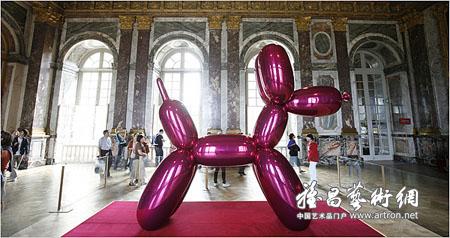Depending on the Culture of Strangers
2011-04-15 12:08:50

PACKAGING art by the decade isn’t realistic; art doesn’t come in squared-off units. But we seem to need handles on history, so that’s what we do. And here we are once again, in 2010, trying to make a chronological chunk of art — 2000s art, or new millennium art, or art of the aughts — make sense. Whatever you call the art of the last decade, there was a ton of it. Has the world ever turned out more, in more varieties, than in the last 10 years? I doubt it.
The 2000s really started in the late 1990s. In the early years of that decade the American economy was in woeful shape, the art market a shambles. AIDS and the culture wars raged. At the same time multiculturalism and a budding globalism were opening doors. Not only were we seeing African-American, Latino and Asian-American artists stepping onto the stage in New York in unprecedented numbers, but we were getting news from art centers in Africa, Latin America and Asia.
Art reflected the realities of the day, good and bad, with a new kind of content: politically informed, activist in spirit, often self-consciously ethnic in reference. Some of the work was polished, some scrappy. That it was happening at all was intensely interesting. Some work you liked, some you didn’t; this, as always, came down to personal taste. History moved ahead a step.
By 2000 the economy was a few years on the rebound. Chelsea had happened. Sales were going great. Politics, viewed by the New York market as yesterday’s news, seemed distanced, or disguised or put on the shelf. The words “beauty” and “pleasure” were on insider lips. Painting was embraced like a monarch returned from exile — at last the uprising was over — and just in time to meet the retail demands of that most characteristically 2000s phenomena: the art fair.
Then came Sept. 11, 2001. Pundits spoke: The catastrophe marked a cultural watershed, the beginning of a new seriousness, the death of irony. Everything, including art, would change. But art didn’t change. It stayed exactly the same. Washington told Americans to spend, keep the economy pumped, and the art industry did its patriotic duty.
As the 2000s progressed, we got acres of well-schooled paintings and drawings. We got Damien Hirst (talk about yesterday’s news) at the Met, and Jeff Koons, with his big-ticket baubles and vote-for-me smile, at every turn. Leftovers by modern masters and demi-masters (Picasso, Warhol, Klimt) were taken for wonders. Art fairs grew on top of art fairs. Did I mention that United States had started a war in Iraq? The art world didn’t mention it either.
This is one view of the decade and a New York-centric one. More global perspectives are possible, to say the least. During the 2000s what began as a contemporary art boom in China grew into a colossal industry. Beijing alone had hundreds of galleries in multiple art districts. If much of the art was throw-away stuff, so is much new art everywhere.
Thanks to a flourishing Asian economy, the decade also saw the exponential growth of the contemporary art scene in India. A handful of its artists became staples of international art festivals, though relatively few of them showed in New York. In part this is because there are only a few galleries here devoted to this art, but also because, one suspects, Indian artists weren’t looking to New York for affirmation. They were involved in their own cosmopolitan and self-sustaining art world, and it kept them very busy.
The decade was rich in new art from Africa, though we saw relatively little of it first hand. But we were given an extraordinary historical exhibition on the subject of African modernism in “The Short Century: Independence and Liberation Movements in Africa, 1945-1994.” Organized by the Nigerian-born curator Okwui Enwezor, it opened in Europe in 2001 and traveled to New York the following year.
It was one of the decade’s most important shows.
So was another historical survey, “Inverted Utopias: Avant-Garde Art in Latin America,” at the Museum of Fine Arts, Houston in 2004, which cast comparable illumination on Latin American modernism. Its curators, Mari Carmen Ramírez and Héctor Olea, served notice that in contradiction to long-held stereotypes, 20th-century Latin-American art was not: a) restricted in theme to religion and revolution; b) unitary but made up of diverse countries and cultures; and c) derivative of European modernism but supplying Europe with new information.
Finally, perhaps most significantly, the 2000s brought us face to face with Islamic cultures. In the days after 9/11, many art-loving New Yorkers felt impelled to visit the overlooked Islamic galleries at the Metropolitan Museum, as if to get some grasp of a religion suddenly central to their lives. Through an accident of timing, the galleries closed for renovation soon thereafter, not to reopen until 2011. In 2008, however, a spectacular museum of Islamic art opened in Qatar, and the Met made one of the hires of the decade by bringing in Sheila R. Canby from the British Museum as curator-in-charge of its Islamic collection.
The invasion of Iraq drew attention to the malignant realities of archaeological looting and to the besetting question of who really owns what. Calls for the repatriation of art held in major American museums resounded through the decade and are not likely to end. Thomas P. Campbell, the Met’s director as of 2007, will undoubtedly be called upon sooner than later to determine institutional policy. His decisions will be more than closely watched.
Mr. Campbell’s appointment was, of course, one of the decade’s major New York museum changes. There were others. The American Folk Art Museum, the New Museum of Contemporary Art and the Museum of Art and Design all got new homes. The Museum of Modern Art expanded, as did El Museo del Barrio and the Bronx Museum of the Arts.
In addition, during the 2000s the city’s art institutions entered the digital age, exploiting display and communication possibilities barely tapped before. Artists also picked up on digital technology in a big way. Many now use these resources as supplements to photography, video and painting. More intriguingly, some take digital technology itself, including the Internet, as a primary medium, pioneering future-directed forms that would seem ripe for broad-based exploration.
That probably won’t happen any time soon though. Digital is hard to market. And after the recent economic scare the New York art world is scrambling back to business as usual, which means business before all else. This kind of cautious and conservative thinking made 2000s art at best a thing of only minor excitements, more often simply expendable, and beside the point. In the real world the news of the decade was 9/11, two awful wars, staggering corporate greed and the election of an African-American president. In the art world a big event was Mr. Koons showing his sculptures at Versailles. In short, life passed art by. Maybe in the new decade they’ll meet.

 黄琦
黄琦 武中奇
武中奇 测试用艺术
测试用艺术
